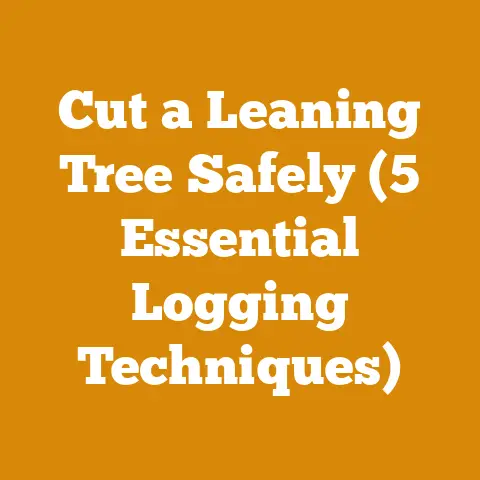Utility Trailer Wood Floor Benefits (5 Key Tips for Durability)
Imagine the gleam in a child’s eyes, watching a parent or grandparent expertly maneuver a chainsaw, transforming a fallen tree into a winter’s worth of warmth. Or the quiet satisfaction of stacking firewood, knowing you’re providing comfort and security for your family. These are the moments that fuel our passion for wood processing, logging, and everything in between. And one often overlooked, yet crucial, component of many wood-related projects is the humble utility trailer.
More specifically, the floor of that trailer. Think of it as the unsung hero of your operation, silently bearing the weight of logs, firewood, and tools. A flimsy floor can quickly become a costly liability. That’s why I’m diving deep into the world of utility trailer wood floors, focusing on how to maximize their durability and, ultimately, save you money in the long run.
Utility Trailer Wood Floor Benefits: 5 Key Tips for Durability
A strong, durable wood floor is the backbone of any utility trailer used for hauling heavy loads like logs and firewood. Neglecting its condition can lead to premature failure, costly repairs, and even dangerous situations. Let’s explore the key benefits and how to achieve maximum durability.
1. Choosing the Right Wood: Species, Thickness, and Quality
The foundation of a durable trailer floor lies in selecting the right wood. This isn’t just about grabbing the cheapest option at the local lumberyard; it’s about understanding the properties of different wood species and how they relate to the demands of your work.
-
Species Selection:
- Hardwoods: Generally, hardwoods like oak, maple, and hickory are superior choices due to their high density and resistance to wear and tear. They can withstand the constant abrasion from loading and unloading logs and firewood. However, hardwoods tend to be more expensive.
- Softwoods: While less durable, softwoods like pressure-treated pine or fir can be viable options, especially if you’re on a tighter budget. Pressure treating provides resistance to rot and insect infestation, which is crucial for outdoor use. However, they will require more frequent replacement.
- Exotic Options: For extreme durability, consider options like Ipe (Brazilian Walnut) or other tropical hardwoods. These are incredibly dense and resistant to rot, insects, and wear. However, they are significantly more expensive and can be harder to work with.
- My Experience: I once made the mistake of using untreated pine for a trailer floor. Within two years, it was riddled with rot and needed complete replacement. The cost of that replacement far outweighed the initial savings.
-
Thickness Matters: The thickness of the wood directly correlates to its load-bearing capacity and resistance to deflection (bending).
-
General Recommendation: I recommend a minimum thickness of 2 inches for hauling heavy loads like logs. For lighter loads like firewood, you might get away with 1.5 inches, but I still advise erring on the side of caution.
- Span Considerations: The distance between the trailer’s frame supports (crossmembers) also influences the required thickness. Longer spans require thicker wood to prevent sagging. Measure the distance between your trailer’s crossmembers. If it’s greater than 24 inches, consider increasing the floor thickness.
-
Quality is Key: Even with the right species and thickness, the quality of the wood itself is paramount.
-
Grading: Look for wood graded as “Select Structural” or better. This indicates that the wood is free from major defects like knots, splits, and excessive grain runout, all of which can weaken its structural integrity.
- Moisture Content: Ensure the wood is properly dried to minimize shrinkage and warping after installation. I aim for a moisture content of 12-15% for exterior applications. You can use a moisture meter to check this.
- Treatment: For softwoods, pressure treatment is essential. Look for wood treated with an appropriate preservative for ground contact or exterior use.
Cost Considerations:
- Timber Prices: According to recent data from the USDA Forest Service, lumber prices fluctuate significantly based on species, grade, and region. As of late 2024, expect to pay anywhere from \$3 to \$8 per board foot for hardwoods like oak or maple, and \$1 to \$4 per board foot for pressure-treated pine. Keep in mind that these are average prices, and local market conditions can significantly influence the final cost.
- My Budgeting Tip: Don’t just focus on the initial cost per board foot. Consider the long-term cost of ownership. A more expensive hardwood floor might last twice as long as a softwood floor, ultimately saving you money on replacement costs.
2. Proper Installation Techniques: Securing the Floor for Longevity
Even the best wood will fail prematurely if it’s not installed correctly. Proper installation is crucial for distributing the load evenly and preventing stress concentrations that can lead to cracking and splitting.
-
Fastener Selection:
- Type: I strongly recommend using galvanized or stainless-steel fasteners to prevent rust and corrosion. Avoid using drywall screws or other brittle fasteners, as they can snap under stress. Deck screws are a good option.
- Size and Spacing: The size and spacing of the fasteners depend on the thickness of the wood and the spacing of the trailer’s frame supports. As a general rule, use screws that are at least 2.5 times the thickness of the wood and space them every 12-18 inches along each support.
- Pre-Drilling: Always pre-drill pilot holes before driving screws, especially with hardwoods. This prevents the wood from splitting and makes it easier to drive the screws straight.
-
Attachment Methods:
-
Direct Attachment: The most common method is to directly screw the wood to the trailer’s frame. Ensure that the screws are countersunk to prevent them from protruding and snagging on loads.
- Floating Floor: In some cases, a “floating” floor can be beneficial. This involves attaching the wood to a subframe that is then attached to the trailer’s frame. This allows for some movement and expansion, reducing stress on the wood. However, it adds complexity and cost to the installation.
-
Sealing and Protection:
-
Sealant: Before installing the wood, apply a sealant to the top of the trailer’s frame to prevent moisture from wicking into the wood from below. I use a flexible polyurethane sealant for this purpose.
- Wood Preservative: Apply a wood preservative to all sides of the wood, especially the edges and ends, to protect against rot and insect infestation.
- My Tip: Pay close attention to the end grain of the wood, as it absorbs moisture much faster than the face grain. Apply multiple coats of preservative to the end grain.
Cost Considerations:
- Fastener Costs: Galvanized or stainless-steel screws can range from \$0.10 to \$0.50 per screw, depending on size and quality. The total cost will depend on the size of your trailer and the spacing of the screws.
- Sealant and Preservative: A gallon of sealant can cost around \$20 to \$40, while a gallon of wood preservative can range from \$15 to \$30.
- Installation Labor: If you’re not comfortable installing the floor yourself, expect to pay a professional contractor anywhere from \$50 to \$100 per hour for labor. The total cost will depend on the size of your trailer and the complexity of the installation.
3. Regular Maintenance: Extending the Life of Your Wood Floor
A well-maintained wood floor can last significantly longer than one that is neglected. Regular maintenance involves inspecting the floor for damage, cleaning it, and applying protective coatings.
-
Inspections:
- Frequency: I recommend inspecting your trailer floor at least twice a year, preferably in the spring and fall.
- What to Look For: Look for signs of rot, cracks, splits, loose fasteners, and excessive wear. Pay close attention to areas that are frequently exposed to moisture or heavy loads.
- My Story: I once caught a small area of rot on my trailer floor during a routine inspection. By addressing it immediately with a wood hardener and sealant, I was able to prevent it from spreading and avoid a costly repair.
-
Cleaning:
-
Frequency: Clean your trailer floor regularly to remove dirt, debris, and other contaminants that can accelerate wear and tear.
- Method: Use a broom or a pressure washer to clean the floor. Avoid using harsh chemicals or detergents, as they can damage the wood.
- Drying: Allow the floor to dry completely after cleaning to prevent rot.
-
Protective Coatings:
-
Types: Apply a protective coating to the floor to protect it from moisture, UV radiation, and abrasion. Options include wood sealants, stains, and paints.
- Frequency: Reapply the coating every 1-2 years, or as needed, depending on the wear and tear.
- My Preference: I prefer using a penetrating oil-based sealant, as it soaks into the wood and provides long-lasting protection without forming a film that can crack and peel.
Cost Considerations:
- Cleaning Supplies: Cleaning supplies like brooms, pressure washers, and detergents can cost anywhere from \$20 to \$200, depending on the quality and features.
- Protective Coatings: A gallon of wood sealant or stain can range from \$20 to \$50, while a gallon of paint can cost from \$15 to \$30.
- Labor: If you hire someone to clean and coat your trailer floor, expect to pay around \$30 to \$50 per hour.
4. Load Distribution: Preventing Overload and Uneven Stress
The way you load your trailer can have a significant impact on the lifespan of the wood floor. Proper load distribution helps to prevent overload and uneven stress, which can lead to cracking and splitting.
-
Even Weight Distribution:
- Centering the Load: Always try to center the load over the trailer’s axles. This helps to distribute the weight evenly and prevent excessive stress on any one area of the floor.
- Side-to-Side Balance: Ensure that the load is balanced from side to side. An unbalanced load can put undue stress on one side of the trailer and cause it to lean or sway.
- My Lesson Learned: I once overloaded one side of my trailer with firewood, and it caused the floor to crack along the frame rail. It was a costly mistake that taught me the importance of proper load distribution.
-
Weight Limits:
-
Know Your Limits: Be aware of the trailer’s weight capacity and never exceed it. The weight capacity is usually listed on a sticker on the trailer.
- Consider the Wood: Also, consider the weight capacity of the wood floor itself. A thinner floor will have a lower weight capacity than a thicker floor.
-
Spreading the Load:
-
Use Dunnage: When hauling heavy items, use dunnage (pieces of wood or other material) to spread the load over a larger area of the floor.
- Avoid Point Loads: Avoid concentrating the weight on a single point, as this can cause the floor to dent or crack.
Cost Considerations:
- Dunnage: Dunnage can be made from scrap wood or purchased from a lumberyard. The cost will depend on the type and quantity of dunnage you need.
- Scales: If you frequently haul heavy loads, consider investing in a set of portable scales to ensure that you’re not exceeding the trailer’s weight capacity. A good set of scales can cost anywhere from \$100 to \$500.
5. Protecting Against the Elements: Minimizing Moisture and UV Damage
Exposure to the elements, especially moisture and UV radiation, can significantly shorten the lifespan of a wood trailer floor. Taking steps to protect against these elements can help to extend its durability.
-
Covering the Trailer:
- Tarp: When the trailer is not in use, cover it with a tarp to protect it from rain, snow, and sun.
- Garage or Shed: If possible, store the trailer in a garage or shed to provide even greater protection from the elements.
-
Water Drainage:
-
Slope: Ensure that the trailer floor is slightly sloped to allow water to drain off.
- Drain Holes: Drill drain holes in the floor to allow water to escape. Be sure to position the holes so they don’t weaken the floor.
- My Trick: I use a small drill bit to create several drain holes along the edges of the floor. This allows water to escape without compromising the structural integrity of the wood.
-
UV Protection:
-
Sealant with UV Inhibitors: Use a wood sealant that contains UV inhibitors to protect the wood from the damaging effects of the sun.
- Shade: Park the trailer in a shady area whenever possible to minimize exposure to UV radiation.
Cost Considerations:
- Tarp: A good quality tarp can cost anywhere from \$20 to \$100, depending on the size and material.
- Sealant with UV Inhibitors: A gallon of sealant with UV inhibitors can range from \$30 to \$60.
- Storage: The cost of storing your trailer in a garage or shed will depend on the location and size of the storage facility.
Budgeting for Utility Trailer Wood Floor Maintenance and Replacement: A Detailed Breakdown
Now that we’ve covered the key tips for ensuring the durability of your utility trailer’s wood floor, let’s dive into the nitty-gritty of budgeting for its maintenance and potential replacement. I’ll share my personal experiences and industry benchmarks to help you make informed decisions.
Understanding the Cost Factors
Before we start crunching numbers, it’s crucial to understand the various factors that can influence the cost of maintaining or replacing your trailer floor. These include:
- Wood Species and Quality: As discussed earlier, the type of wood you choose will significantly impact the cost. Hardwoods are generally more expensive than softwoods.
- Floor Thickness: Thicker wood requires more material and will therefore be more expensive.
- Trailer Size: The larger the trailer, the more wood you’ll need, and the higher the cost.
- Installation Method: A simple direct attachment will be less expensive than a more complex floating floor installation.
- Your DIY Skills: If you’re comfortable doing the work yourself, you’ll save on labor costs.
- Location: Lumber prices and labor rates can vary significantly depending on your geographic location.
- Seasonality: Lumber prices tend to fluctuate with the seasons, with prices often being higher during peak construction periods.
Estimating Maintenance Costs
Regular maintenance is key to extending the life of your trailer floor and avoiding costly replacements. Here’s a breakdown of the typical costs associated with maintenance:
-
Cleaning:
- DIY: If you do it yourself, the cost is minimal – just the cost of a broom and some water (perhaps \$10-\$20 per year).
- Professional: Hiring a professional to clean your trailer floor can cost around \$50-\$100 per cleaning.
-
Inspections:
-
DIY: Inspections are free if you do them yourself.
- Professional: A professional inspection can cost around \$50-\$100 per inspection.
-
Protective Coatings:
-
Material: A gallon of wood sealant or stain typically costs between \$20 and \$50. Assuming you need one gallon for a standard-sized trailer and apply it every two years, the annual cost is \$10-\$25.
- Labor: If you hire someone to apply the coating, expect to pay around \$30-\$50 per hour. The total cost will depend on the size of your trailer and the complexity of the job.
Example:
Let’s say you have a standard-sized utility trailer and you choose to do the cleaning and inspections yourself, but you hire someone to apply a protective coating every two years. Here’s a rough estimate of your annual maintenance costs:
- Cleaning and Inspections: \$0 (DIY)
- Protective Coating (Material): \$10-\$25
- Protective Coating (Labor): \$60-\$100 (assuming 2 hours of labor at \$30-\$50 per hour, divided by 2 years)
Total Annual Maintenance Cost: \$70-\$125
Estimating Replacement Costs
Eventually, even with the best maintenance, your trailer floor will need to be replaced. Here’s a breakdown of the costs associated with replacement:
-
Wood:
- Softwood (Pressure-Treated Pine): \$1-\$4 per board foot. For a standard 6’x12′ trailer with a 2-inch thick floor, you’ll need approximately 144 board feet, costing \$144-\$576.
- Hardwood (Oak or Maple): \$3-\$8 per board foot. For the same trailer, the cost would be \$432-\$1152.
-
Fasteners:
-
Galvanized or stainless-steel screws: \$0.10-\$0.50 per screw. Assuming you need approximately 200 screws, the cost will be \$20-\$100.
-
Sealant and Preservative:
-
Sealant: \$20-\$40 per gallon.
- Wood Preservative: \$15-\$30 per gallon.
-
Labor:
-
If you hire a professional to replace the floor, expect to pay around \$50-\$100 per hour. The total cost will depend on the size of your trailer and the complexity of the job. A typical replacement job can take anywhere from 8 to 24 hours, resulting in labor costs of \$400-\$2400.
Example:
Let’s say you decide to replace the floor of your 6’x12′ trailer with pressure-treated pine and hire a professional to do the work. Here’s a rough estimate of the total cost:
- Wood: \$144-\$576
- Fasteners: \$20-\$100
- Sealant and Preservative: \$35-\$70
- Labor: \$400-\$2400 (assuming 8-24 hours of labor at \$50-\$100 per hour)
Total Replacement Cost: \$599-\$3146
My Real-World Example:
A few years ago, I replaced the floor of my 5’x10′ utility trailer with pressure-treated pine. I did the work myself, so I only had to pay for the materials. Here’s a breakdown of my costs:
- Wood: \$120
- Fasteners: \$30
- Sealant and Preservative: \$40
Total Cost: \$190
This example highlights the significant savings you can achieve by doing the work yourself. However, it’s important to be realistic about your skills and abilities. If you’re not comfortable working with wood or don’t have the necessary tools, it’s best to hire a professional.
- Shop Around for Lumber: Get quotes from multiple lumberyards to ensure you’re getting the best price.
- Consider Salvaged Lumber: If you’re on a tight budget, consider using salvaged lumber. You can often find good quality lumber at a fraction of the cost of new lumber. However, be sure to inspect the lumber carefully for rot, insect damage, and other defects.
- Buy in Bulk: If you have multiple trailers or anticipate needing lumber for other projects, consider buying in bulk to save money.
- Do It Yourself: As my personal example shows, doing the work yourself can save you a significant amount of money.
- Prioritize Maintenance: Regular maintenance can prevent costly replacements down the road.
- Plan Ahead: Don’t wait until your trailer floor is falling apart to start planning for its replacement. Start saving money and researching your options well in advance.
- Consider Financing: If you need to hire a professional to replace your trailer floor, consider financing the project. Many contractors offer financing options.
Global and Regional Cost Variations
It’s important to remember that lumber prices and labor rates can vary significantly depending on your geographic location. Here are some general observations:
- North America: Lumber prices in North America are generally lower than in Europe or Asia.
- Europe: Lumber prices in Europe are generally higher than in North America, but labor rates may be lower in some countries.
- Asia: Lumber prices in Asia can vary widely depending on the country. Labor rates are generally lower than in North America or Europe.
- Regional Variations: Even within a single country, lumber prices and labor rates can vary significantly depending on the region. For example, lumber prices in rural areas may be lower than in urban areas.
To get the most accurate cost estimates, I recommend contacting local lumberyards and contractors in your area.
Actionable Takeaways and Next Steps
Maintaining and budgeting for your utility trailer’s wood floor doesn’t need to be a daunting task. By understanding the key benefits of a durable floor, implementing the five tips for longevity outlined in this article, and carefully planning your budget, you can ensure that your trailer is ready to handle the demands of your wood processing, logging, or firewood preparation projects for years to come.
Here are some actionable takeaways and next steps:
- Assess Your Current Floor: Inspect your trailer floor for signs of damage and determine if it needs maintenance or replacement.
- Choose the Right Wood: Select a wood species and thickness that is appropriate for your needs and budget.
- Plan Your Installation: Decide whether you’ll do the work yourself or hire a professional.
- Create a Budget: Estimate the costs of materials and labor and create a realistic budget for your project.
- Implement a Maintenance Plan: Develop a regular maintenance plan to extend the life of your trailer floor.
- Protect Against the Elements: Take steps to protect your trailer floor from moisture and UV radiation.
- Load Properly: Distribute the load evenly to prevent overload and uneven stress.
Remember, a well-maintained and durable utility trailer wood floor is an investment in your business and your safety. By following these tips and taking a proactive approach to maintenance and budgeting, you can save money, reduce downtime, and ensure that your trailer is always ready to haul your valuable wood products.
Now go out there and put these tips into action! Your trailer (and your wallet) will thank you for it. And who knows, maybe one day you’ll be the one teaching the next generation the joys of wood processing, with a trusty, well-maintained trailer in tow. After all, a little bit of planning goes a long way towards creating lasting memories and ensuring the continued success of your wood-related endeavors.






